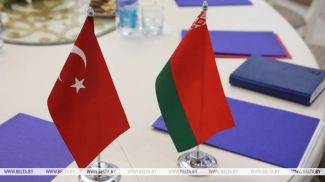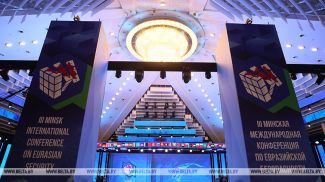The Belarusian State University has created Belarus' first university nanosatellite. Universities all over the world have been known to develop such extremely small spacecraft. Nanosatellites are cheaper and faster to produce than large satellites for the remote sensing of the Earth, but capabilities of the former are getting closer and closer to capabilities of the latter. Such extremely small spacecraft represent a kind of a flying education and research lab for university students. Nanosatellites can be used to cheaply and promptly test new technologies, acquire and process space data, and offer practical training to aerospace industry specialists. BelTA reporters set out to find out when Belarus' first university nanosatellite will be launched, what for, and how this industry will be developed.
The nanosatellite made by the Belarusian State University has all the components its big brother may have: orientation systems, power systems, active stabilization systems, a telecommunication system, and a camera. Yet the nanosatellite weighs only some 2kg and has extremely compact dimensions — 20x10x10cm. The core equipment is of Belarusian make and includes a navigator, a radiation spectrometer, an infrared sensor, and radiation-resistant elements. The Belarusian State University has established a satellite control center and a data reception station. The satellite will use amateur radio frequencies.
Such spacecraft are much cheaper than big-sized satellites. The latter may cost upwards of hundreds of thousands of U.S. dollars while the former may be created for dozens of thousands of U.S. dollars.
Apart from being cheap, nanosatellites boast a number of other advantages. They are fast to produce and can be inserted into orbit as part of a cluster of satellites. It is a cheap technical option that allows freely testing new technologies and staging experiments. Some people believe that the future of space exploration belongs to these extremely small specialized spacecraft. Such satellites are also very effective for education purposes. University students can dabble in creating and operating such spacecraft starting with the idea to create a nanosatellite and ending with the satellite's launch, operation, data processing and usage. “Reading textbooks is one thing but developing a spacecraft of our own and operating it in real conditions is something else entirely,” said Vladimir Sayechnikov, head of the Physics and Aerospace Technologies Chair of the Radio Physics and Computer Technologies Department, scientific supervisor of the Aerospace Education Center at the Belarusian State University.
Nanosatellites do not need expensive components and extreme performance because they are not designed to last long. Experimentation is their core function. Unification is another advantage of nanosatellites. Some components can be 3D printed and specialists from the Belarusian State University actively exploit the technique.
The idea to create nanosatellites in universities emerged comparatively a short time ago. In the end of the 20th century Stanford University came up with a program on developing such spacecraft specifically for educational institutions. Such satellites are assembled using unified components. The compact satellite contains all the systems it needs to work.
For instance, Japan no longer launches large universal spacecraft in favor of launching groups of specialized small satellites. India launched 104 small satellites in one go a short while ago. Of them 96 satellites were American satellites for the remote sensing of the Earth with two-meter resolution. The resolution is on par with capabilities of large satellites. Since a bunch of nanosatellites have been inserted into orbit, they will be able to feed data from a territory that one large satellite is unable to cover at the same time.
Vladimir Sayechnikov said: “In 2003 when the decision to launch Belarus' first satellite was made, the Education Ministry entrusted our university with training specialists for the aerospace industry. The Aerospace Education Center was established back then. Since the very start we've been focusing on three main directions: personnel training, processing and usage of remote sensing data, and the development of an extremely small spacecraft as a flying education and research lab by students. Initially we took care of education and data processing. We started developing our own university nanosatellite in 2014. The Belarusian State University used its own money to create the satellite.” Progress in the work to create the nanosatellite had reached the 90% mark by the beginning of 2017.
“Our key task is to master the full technology for making, launching and operating such spacecraft. We are intent on making all the components in Belarus,” said the scientific supervisor of the Aerospace Education Center at the Belarusian State University.
Students of the Belarusian State University did most of the work involved in creating the satellite under the supervision of their professors. Several departments were involved: the Radio Physics and Computer Technologies Department and the Physics Department while personnel from math departments were invited to crunch data. As many as 24 people are working on the project now. Most of them are students. “Working as part of the project, the students acquire a full set of skills, competences and knowledge in this industry, which is rather new for us. The skills they are going to acquire will come in handy in various spheres because the satellite implements a large number of different systems: power supply, orientation, telecommunications and other ones,” said Vladimir Sayechnikov.
Working on the project, the Belarusian State University has established tight cooperation with other universities. “We've worked with the Berlin Technical University. They have a good track record in this area: ten spacecraft of their own, including five custom-made for commercial companies. Besides, we tightly cooperate with Russian universities such as the Moscow State University, the Bauman State Technical University of Moscow, the Samara State Aerospace University, the Kursk-based Southwest State University, and other ones. Nearly all of them are busy working on similar projects,” said Vladimir Sayechnikov.
The final tests of the Belarusian nanosatellite will be done in OAO Vityas in Vitebsk. The spacecraft and its launch barrel will be subjected to ten gravities in a centrifuge. The testing will be done after the contract on launching the satellite is signed and the launch date is set. For now the Belarusian State University intends to insert it into orbit in late 2017 or early 2018.
“Our satellite will be piggybacked onto some large satellite. We have not decided yet what country and what space agency will launch it,” explained Vladimir Sayechnikov.
Once the nanosatellite is in orbit, the ground-based flight control center will work 24/7. “The satellite will fly over us about six times per day. The radiovisibility window will be 10-11 minutes at most. We will need personnel on duty to handle telemetry, mission information, stage scientific experiments, process data, evaluate the precision of the satellite's orientation, build maps of background radiation and the planet's magnetic anomalies. Students will be involved in all this work,” said the scientific supervisor of the Aerospace Education Center at the Belarusian State University.
Any university and any student will be able to receive the data the nanosatellite will send. Being personally in the flight control center is not required. A small radio receiver plugged into a notebook will suffice. Specialists from the Belarusian State University have developed a dedicated website that allows a huge number of users to acquire data from the satellite. “We would like radio amateurs from all over the world to get involved. We will have a small satellite and limited bandwidth and small connection speeds. If we choose to download data only for ten minutes six times per day, we are not going to have a lot of it. If radio amateurs from all over the planet pitch in, the volume of data will exceed what large satellites can produce. Two projects have been implemented like that — in Canada and Hungary. They have been able to connect up to 2 million users. Can you imagine how much data 2 million users can collect?” wondered Vladimir Sayechnikov.
There are plans to set up a reception network connecting all the Belarusian universities, which will be able to acquire data from this nanosatellite and all the existing educational satellites. “No complicated equipment will be required taking into account the capabilities of the website we have created. For instance, our data reception center gets information from 50 educational satellites,” added the scientific supervisor of the Aerospace Education Center at the Belarusian State University.
It is the first but not the only university nanosatellite that will be created in Belarus. Specialists of the Belarusian State University are already ready to create another one. It will use only Belarusian modules and components. “We expect that the service modules we have developed can be sold on the market. Experts are now looking at the new nanosatellite project. If they okay the idea and we get funding, we will be able to start working as early as this year,” said Vladimir Sayechnikov.
There are plans to work together with Russia in this field. The new Union State program Multi-SAT-SG that will replace the Monitoring-SG program provides for the development and launch of a group of Belarusian-Russian extremely small spacecraft. The group of satellites will allow Belarusian and Russian scientists to conduct scientific experiments together. For now the group is supposed to include a large Russian satellite and at least four small ones from various universities: one from the Belarusian State University and three from Russian universities.
Photos by Yegor Pavlyushchik and from archives of the Belarusian State University.













